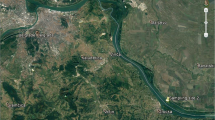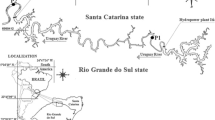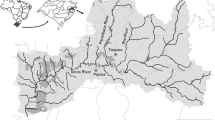Abstract
The river Ravi, while passing through Lahore, the second largest city of Pakistan, gets highly polluted owning heavy loads of untreated municipal sewage and industrial effluents of diverse kinds. The fish, Catla catla sampled in two different seasons from three downstream polluted sites were compared with the samples of the same fish from an upstream, a less polluted site, for their physico-chemical parameters. The data were statistically analysed to study the effect of sites, seasons and their interaction on the physico-chemical parameters of waters and mineral uptake in fish muscles. Significant differences (P < 0.001) among the sampling sites and seasons were observed. The river appeared to be polluted as indicated by the high values of total suspended solids (909 mg/l) and sulphate (964 mg/l) in comparison to the respective values of 150 and 600 mg/l being suggested as the safer values of drinking water of the National Environmental Quality Standards. Most trace and macro elements in fish muscles were increased with the increasing pollution loads from the upstream to the downstream sites of this river. The remarkable increases in the levels of all the investigated minerals in fish muscles from the polluted sites raise concerns about the long-term health of the river Ravi ecosystem and consequently the fish and its consumer’s health. The results contradict the opinion of the local population that the riverine fish are natural, more health-promoting and precious than the pond fish. Therefore, we strongly argue for the utilization of an effect-based monitoring approach to alleviate the detrimental effects of anthropogenic activities on fish and the fish consumers’ health.
Similar content being viewed by others
References
Ali, S. S. (1999). Freshwater fishery biology (1st ed., pp. 108–114). Hyderabad: Naseem Book Depot.
Amundsen, P. A., Staldvik, F. J., Lukin, A., Kashulin, N., Popova, O., & Reshetnilov, Y. (1997). Heavy metals contamination in freshwater fish from the border region between Norway and Russia. Science of the Total Environment, 201(3), 211–224. doi:10.1016/S0048-9697(97)84058-2.
APHA (American Public Health Association), (1985). Standard Methods for the Examination of Water and Wastewater. 16th edition Washington DC.
Atchison, G. J., Henry, M. G., & Sandheinrich, M. B. (1987). Effects of metals on fish behaviour: a review. Environmental Biology of Fishes, 18(1), 11–25. doi:10.1007/BF00002324.
Benjamin, R., Chakrapani, B. K., Devashish, K., Nagarathna, A. V., & Ramachandra, T. V. (1996). Fish mortality in Bangalore Lakes, India. Electronic Green Journal, 1(6), 1–11.
Chapman, D. (1992). Water quality assessment. London: Chapman and Hall.
Chaudhry, A. S., & Jabeen, F. (2011). Assessing metal, protein and DNA profiles of Labeo rohita from the Indus River in Mianwali, Pakistan. Environmental Monitoring and Assessment, 174, 665–679. doi:10.1007/s10661-010-1486-4.
FEPA (Federal Environmental Protection Agency), (2003). Guildlines and Standards for Environmental Pollution Control in Nigeria.
Garg, S. K., Bhatnagar, A., Kalla, A., & Johal, M. S. (2000). Experimental ichthyology. New Delhi, India: CBS.
Jabeen, F., & Chaudhry, A. S. (2010). Monitoring trace metals in different tissues of Cyrinus carpio from the Indus river in Pakistan. Environmental Monitoring and Assessment, 170(1–4), 645–656. doi:10.1007/s10661-009-1263-4.
Leonard, L. C. (1971). Water and water pollution. Volume 1 (pp. 256–263). New York: Marcel Dekker.
Mahmood, G. (2003). Lead and nickel concentration in fish and water of river Ravi. Pakistan Journal of Biological Sciences, 6(12), 1027–1029.
Malik, N., Biswas, A. K., Qureshi, T. A., Borana, K., & Virha, R. (2010). Bioaccumulation of heavy metals in fish tissues of a freshwater lake of Bhopal. Environmental Monitoring and Assessment, 160(1–4), 267–276. doi:10.1007/s10661-008-0693-8.
Mansour, S. A., & Sidky, M. M. (2002). Ecotoxicological studies. Heavy metals contaminating water and fish from Fayoum Governorate, Egypt. Food Chemistry, 78, 15–22.
McNeil, D. G., & Closs, G. P. (2007). Behavioural responses of a south-east Australian flood plain fish community to gradual hypoxia. Freshwater Biology, 52, 412–420. doi:10.1111/j.1365-2427.2006.01705.x.
Mohan, D., Gaur, A., & Choudhary, D. (2007). Study of limnological and microbiology of Naya Talab Jodhpur (Rajasthan). Proceedings of DAE-BRANS National Symposium on Limnology (NSL), February 19-21, 2007, (pp. 64-68) Udaipur.
Muhammad, A., Shah, F. M., Asadullah, Bangash, G. N., & Zeb, H. (1998). A limnological survey of the river Swat at Mingora, NWFP, Pakistan. Sarhad Journal of Agriculture, 14, 235–240.
National Environmental Quality Standards-NEQS, (2001). Pakistan- Revised NEQS. http://www.elaw.org/node/2691
Nnaji, J. C., Uzairu, A., Harrison, G. F. S., & Balarabe, M. L. (2011). Effect of pollution on the physico-chemical parameters of water and sediments of river Galma, Zaria, Nigeria. Research Journal of Environmental and Earth Sciences, 3(4), 314–320.
Qadir, A., & Malik, R. N. (2011). Heavy metals in eight edible fish species from two polluted tributries (Aik an Palkhu) of the river Chenab, Pakistan. Biological Trace Element Research, 143(3), 1524–40. doi:10.1007/s12011-011-9011-3.
Rauf, A., Javed, M., Ubaidullah, M., & Abdullah, S. (2009). Assessment of heavy metals in sediments of the river Ravi, Pakistan. International Journal of Agriculture and Biology, 11, 197–200.
Saeed, M. M., & Bahzad, A. (2006). Simulation of contaminant transport to mitigate environmental effects of wastewater in river Ravi. Pakistan Journal of Water Resources, 10(2), 43–52.
Sivaperumal, P., Sankar, T. V., & Nair Viswanathan, P. G. (2007). Heavy metals concentrations in fish, Shellfish and fish products from internal markets of India vis-a-vis international standards. Food Chemistry, 102, 612–620.
Subramanian, V. (2004). Water quality in South Asia. Asian Journal of Water and Environmental Pollution, 1, 41–54.
Swann, L. (2000). A fish farmer’s guide to understanding water quality. Illinois–Indiana: Sea grant program, Purdue University.
USEPA, (1999). Biological assessment of the Idaho water quality standards for numeric water quality criteria for toxic pollutants. U.S. EPA, Region 10, Seattle Washington, DC.
Vutukuru, S. S. (2005). Acute effects of hexavalent chromium on survival, oxygen consumption, hematological parameters and some biochemical profiles of the Indian Major carp, Labeo rohita. International Journal of Environmental Research and Public Health, 2(3), 456–462.
WHO (World Health Organization). (1985). Guidelines for drinking water quality vol. 1. Recommendation (p. 130). Geneva: WHO.
Wright, D. A., & Welbourn, P. (2002). Environmental toxicology (Cambridge Environmental Chemistry Series 11). Cambridge: Cambridge University Press.
Yang, J., Zhang, G., & Zhao, Y. (2004). Land use impact on nitrogen discharge by stream: a case study in subtropical hilly region of China. Earth and Environmental Science, 77, 29–38.
Yausafzai, A. M., Khan, A. R., & Shakoori, A. R. (2010). Pollution of large, subtropical rivers-river Kabul, Khyber-Pakhtun Khwa province, Pakistan: physico-chemical indicators. Pakistan Journal of Zoology, 42(6), 795–808.
Acknowledgements
Thanks to the Higher Education Commission , Pakistan for funding the first author under the “Indigenous Ph.D. 5000 Fellowship program” and “IRSIP” to support this research at University of the Punjab, Pakistan and Newcastle University, UK.
Author information
Authors and Affiliations
Corresponding author
Rights and permissions
About this article
Cite this article
Shakir, A., Chaudhry, A.S. & Qazi, J.I. Impact of anthropogenic activities on physico-chemical parameters of water and mineral uptake in Catla catla from river Ravi, Pakistan. Environ Monit Assess 185, 2833–2842 (2013). https://doi.org/10.1007/s10661-012-2753-3
Received:
Accepted:
Published:
Issue Date:
DOI: https://doi.org/10.1007/s10661-012-2753-3




